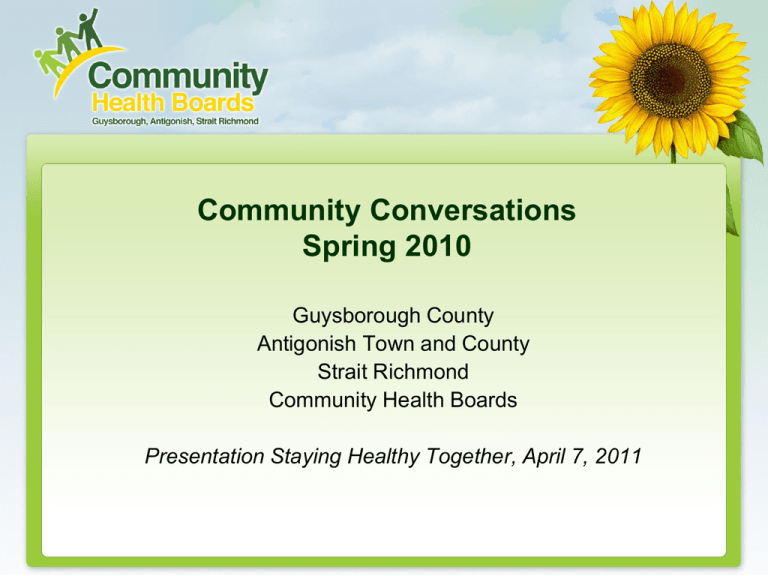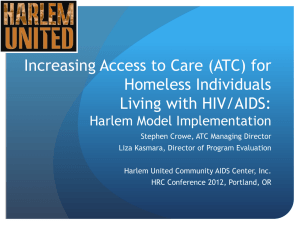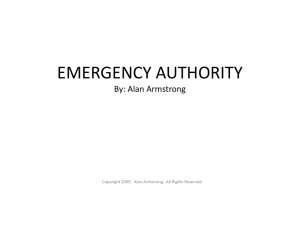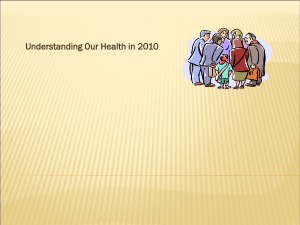Community Conversations
advertisement

Community Conversations Spring 2010 Guysborough County Antigonish Town and County Strait Richmond Community Health Boards Presentation Staying Healthy Together, April 7, 2011 Planning Process • Gathering information through community engagement • Workshops to develop the plan • Identify Strategic Directions and Recommendations • Develop CHB Operational Plans How did we engage the community? • Community Conversations • Understanding Our Health Survey • Presentations from GASHA Departments and Community Agencies • Direct links to community organizations and coalitions • Reviewed other information and relevant reports Community Conversations - Purpose • Provide information and discussion on important health issues • Identify factors affecting health • Identify and prioritize the serious health issues • Identify some ways to address health issues • Identify effective communication strategies Community Conversations • 40 Focus Groups held across the district – 36 reports • 344 participants • Included geographic communities as well as specific populations: youth, young families, seniors, African Nova Scotians, Acadian/francophone and First Nation communities, the business sector, and community agencies. Lack of Physical Activity - 50% (18/36) For Youth, Seniors and Young Families • Access to motivational fitness and wellness leaders (ATC; SR) • Organized recreational activity in local communities (SR; ATC; GC); • Leadership by those responsible for recreational activities (ATC); • Young people need more physical activity (ATC; SR); • Safe walking routes for seniors (ATC); • Accessible, affordable, local, and age appropriate programs and facilities, including attention to the needs of seniors (SR); • Equipment, education, and some organized fitness programs Introduce equipment better and at younger age (GC). Poor Nutrition – Obesity: 78% (28/36) • • • • • • Poor nutrition, unhealthy eating, poor eating habits (ATC; SR; GC); Lack of awareness of healthy food choices (GC.); Need good reliable information and knowledge of community gardens (ATC; GC); Easy access to junk food and convenience foods (ATC; SR); Use of technology encourages inactivity and bad eating habits (ATC; SR); Lack of access to healthy food choices (GC). Need for Prevention & Wellness: 39% (14/36) • Need prevention and wellness activities in our communities (SR; ATC); • Need for awareness and education about benefits of changing lifestyles (GC); • Need more focus on relationship between physical activity and wellness (ATC). Need for Supportive Environments: 39% (14/36) • Need support systems and motivation to facilitate understanding that change is required (GC); • Need support from friends, family, and extended family; for example, not giving kids unhealthy food. (GC.); • Need to support and motivate youth (GC.); • Need increased workplace wellness, physical activity opportunities at work, and support for employees and employers; for example a tool kit for employers (SR). Addictions & Substance Abuse: 56% (20/36) • • • • • • • • • • Drugs, alcohol and gambling, both youth and adults (SR); Drugs, smoking, alcohol concerning to youth (ATC); Many adults are smoking and using drugs and alcohol (GC); Access is easy for youth. Adults help youth get drugs, alcohol and cigarettes (GC); People have multiple addictions (GC); High percentage of youth in school smoke (GC); Smoking an issue, especially with young families (ATC); Peer Pressure – youth want to fit in (GC); Starting younger in usage (GC); Lack of enforcement by police for smoking underage (GC). Chronic Disease: 50% (18/36) • In all three CHB areas, diabetes identified as a health issue; including, African Nova Scotians and First Nations communities. • In the Guysborough County CHB area, cancer, and heart disease were also identified as priority health issues. • In Antigonish County, cancer was identified as the top priority health issue by one focus group. Factors Affecting Chronic Conditions • Lack of physical activity • Obesity, poor diet and lack of awareness of healthy food choices • Mental health issues, such as stress • Drugs, drinking and smoking • Lack of education and information • Access to services and transportation • Lack of supports, programs and isolation • Lack of motivation; people have difficulty making changes • Economic issues, low and fixed income; high cost of healthy food and drugs • Pollution Mental Health – 58% (20/36) Factors Contributing to Mental Health • Isolation and loneliness, particularly for elderly in rural communities; • Stress and time management for students and young families; • Relationship between mental health and having a chronic condition; • Other factors such as economic stress, relationship issues, racism, stereotypes/stigma, low literacy, lack of physical activity, and family history. Mental Health – 58% (21/36) Access to Services • Lack of self awareness about mental health status and conditions, hence the need for “mental health literacy;” • Lack of awareness about services available; • Stigma remains a barrier to accessing mental health services; • Need for more community-based programs, support and self help groups; First Nations Communities • Report mental health as a major health issue. Discharge planning is of particular concern. • Memorandum of Understanding (MOU) - mental health one area outlined for action What We Heard from our Consultation - Access Key challenges: • Growing seniors population requiring supportive environments • Homecare requires improvements • Public transportation • Better access to health information and services & programs • Community-based services & programs closer to home • Continue to improve services to communities that have been historically excluded and marginalized • Implementation of Dr. John Ross report will require full community consultation and attention to recruitment and retention of staff. Seniors – Supportive Environments 39% (14/36) • Growing Aging Population • Adequate, affordable housing • Homecare • Rural transportation • Elder abuse • Safe places for walking & physical activity • Poverty • Cost barriers to programs & services • Lack of communication & awareness about services & programs • Housing supports for snow removal, lawn mowing, etc. • Isolation: support systems for elderly and caregivers; smaller families and people moving away. Access to Homecare • Gap in supportive care upon leaving hospital and returning to home (ATC); • Cost of and access to adequate caregivers which would allow seniors to stay in own home (ATC); • Need support systems for elderly and their caregivers (SR; ATC); • Home care services received are very limited and need to be expanded (SR); • Housing supports for seniors and individuals living by themselves for snow removal, lawn mowing etc. (SR). Transportation – 58% (21/36) Antigonish Town & County CHB area: • Affordable and accessible transportation - over ½ of focus groups. Lack of rural transportation, especially for seniors. Strait Richmond CHB area, • Affordable transportation – in particular lack of access to services Guysborough County CHB area - one of priority health issues • Lack of transportation to appointments, clinics and education programs as well as lack of access to programs and facilities. • African Nova Scotian community of Lincolnville - lack of public transportation major issue in accessing services and programs as many residents do not have cars. Communication and Engagement 47% (17/36) • More information about community programs & services in local communities (GC; SR; ATC); • Access to health information (AC; SR; GC) • More promotion on what to do to improve health (SR). • Suggestions to promote programs and services: brochures in communities; information on internet and website; CAP sites to have safe health links; pamphlets available on reliable health links; promotion of the 811 service. (GC; SR; ATC); Supportive Environments for Young Families: 28% (10/36) • Child and parenting supports • Child care in order to access programs • Locally organized recreational activities • Isolation and stress - many young mom’s are on their own – ‘single moms’ while partners are working away • Need to keep young families in our communities through support for economic sustainability Community-based Services/Programs 83% (30/36) • Chronic disease programs/self help groups, support programs (ATC, GC, SR) • Health education (ATC, GC, SR) • Screening programs - monthly clinics (ATC, GC, SR) • Outreach health and wellness programs (ATC, GC, SR) • Expanded hours at existing walk-in clinic; more walk-in clinics and clinical services, youth health centres (ATC, GC, SR) • Community gardens; good nutrition, meal preparation, healthy meal planning (ATC, GC, SR) Health Inequities Physical & Built Environments: 22% (8/36) Strait Richmond CHB area: • Safe drinking water; particularly well water; education about water testing; cost for well water test can be a barrier to testing. Guysborough County CHB: • Education and better information about well water testing and how the test works. • Lincolnville identified insufficient water supply as one of their priority health issues. Strait Richmond and Antigonish Town & County CHB areas • Safe areas for walking, particularly those living in rural areas. Health Inequities – Poverty/Income 39% (14/36) In all three CHB areas, poverty identified as a factor affecting health and linked to a number of other factors as follows: • Food security and ability to buy nutritious food; • Ability to access to services due to lack of transportation, especially in rural areas; • Adequate and affordable housing; • Ability to access recreation opportunities; • Ability to participate in programs due to cost barriers; • Access to prescriptions due to costs. What We Heard from Consultation: Youth (7 gps) • Most common health issues: (1) mental health (2) drugs, smoking and alcohol; and (3) obesity. • Need places for youth to gather – youth health centres & after school recreational and social activities • Affordability & transportation in rural areas critical to engaging youth • Need to improve physical activity levels • Healthy eating/obesity need to be addressed • Readiness for change to improve health and wellbeing identified factors to help increase physical activity levels • Reseau Sante – Nouvelle Ecosse youth focus groups similar issues Strategic Directions 1. Strengthening & Supporting Mental Health in Our Communities 2. Implementing a Comprehensive Community-based Chronic Disease Strategy 3. Promoting & Supporting Healthy Living 4. Building Bridges to Youth Health 5. Facilitating Access to Services & Programs 6. Addressing Inequities to Improve Health 7. Promoting Communication with Communities & with GASHA 8. Enabling Health Planning & Coordination CHB Focus Group Conclusions • Results reinforced issues from Understanding Our Health Survey • Multiple factors contribute to health of populations (seniors, youth, those living in poverty) • Access and health inequities critical to address in rural areas • Need to consider determinants of health and health inequities in delivery of all services • Need to focus on youth as our most critical health promotion and prevention strategy. • Recommendations: community-based and collaborative services will ensure more wholistic approach to improving health Thank you! Questions Comments











